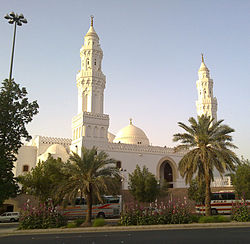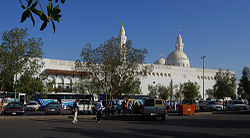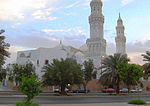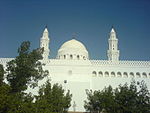- Masjid al-Qiblatain
-
Masjid al-Qiblatain 
The main entrance to the Masjid al-Qiblatain.
Basic information Location  Medina, Saudi Arabia
Medina, Saudi ArabiaGeographic coordinates 24°29′02.71″N 39°34′44.07″E / 24.4840861°N 39.5789083°E Affiliation Islam Architectural description Architectural type Mosque Completed 623 Specifications Capacity 2000 Dome(s) 1 Minaret(s) 2 Masjid al-Qiblatain (المسجد القبلتین) (Mosque of the two Qiblas) is a mosque in Medina that is historically important for Muslims as the place where the Islamic prophet Muhammad, leading the prayer, is said to have been commanded to change the direction of prayer (qibla) from Jerusalem to Mecca. Thus it uniquely contained two prayer niches (mihrabs). Recently the mosque was renovated, removing the old prayer niche facing Jerusalem and leaving the one facing Mecca.
The Qiblatain Mosque is among the three earliest mosques in Islam's history, along with Quba Mosque and Al-Masjid al-Nabawi.
Contents
History
The name of the mosque goes back to the beginning of Islam when the companions of Muhammad named it after an event that took place. Muhammad was leading the prayer when he received a revelation from Allah instructing him to take the Kaaba as the Qiblah. According to traditional accounts, Muhammad, who had been facing Jerusalem during the prayer, upon receiving this revelation, immediately turned around to face Mecca, and those praying behind him also did so. After this, the mosque in which this incident occurred came to be known as Masjid al-Qiblatain (i.e. 'Mosque of the Two Qiblas'). Many pilgrims who go to Mecca for hajj often visit Medina where some end up visiting the notable Qiblatain because of its historic signficance.[1]
Quran
“ We see the turning of thy face (for guidance) to the heavens: now Shall We turn thee to a Qibla that shall please thee. Turn then Thy face in the direction of the sacred Mosque: Wherever ye are, turn your faces in that direction. The people of the Book know well that that is the truth from their Lord. Nor is God unmindful of what they do. ” Hadith
Sahih Bukhari[2] says;
“ Narrated Ibn Umar: While some people were offering Fajr prayer at Quba' (mosque), some-one came to them and said, "Tonight some Qur'anic Verses have been revealed to the Prophet and he has been ordered to face the Ka'ba (at Mecca) (during prayers), so you too should turn your faces towards it." At that time their faces were towards Sham (Jerusalem) so they turned towards the Ka'ba (at Mecca).
” Structure
The mair prayer hall adopts rigid orthogonal geometry and symmetry which is accentuated by the use of twin minarets and twin domes. Living accommodations for the Imam, the Muezzin and the caretaker are discreetly grouped it one block to the west of the main structure. The difference in level at the southeast corner of the site has been exploited to incorporate a sub-basement level which serves as the ablutions area for worshippers.
To the north, where the ground level is lower, the prayer hall is raised one-storey above ground level. Entry to the prayer hall is from the raised courtyard, also to the north, which can be reached by stairs and ramps from the main directions of approach. The prayer hall consists of a series of arches which support barrel-vaults running parallel to the qibla wall. These vaults are interrupted by two domes which establish an axis in the direction of Mecca.
The main dome to the south is raised on a drum of clerestory windows which allow light to filter into the interior directly above the mihrab. The second, false dome is linked to the first by a small cross-vault to symbolise the transition from one qibla to another. Below it, a replica of the mihrab found in the lower chamber of the Dome of the Rock in Jerusalem reminds onlookers of the oldest extant mihrab of Islam. Externally, the architectural vocabulary is inspired by traditional elements and motifs in a deliberate effort to offer an authentic image for an historic site.
The mosque is located on the north-west of the city of Medina, on Khalid bin al-Waleed road. The mosque was initially maintained by Caliph Umar ibn al-Khattāb. By the rise of the Ottoman empire the mosque was maintained by Sultan Suleiman the Magnificent who renovated and reconstructed it.
See also
- Quba Mosque
- Timeline of Muslim history
- Islamic architecture
- Islamic art
- List of the oldest mosques in the world
References
- ^ A life that matters: a spiritual experience By Norani Noridin and Nordin Yusof - Page 32
- ^ "CRCC: Center For Muslim-Jewish Engagement: Resources: Religious Texts". Usc.edu. http://www.usc.edu/schools/college/crcc/engagement/resources/texts/muslim/hadith/bukhari/060.sbt.html#006.060.018. Retrieved 2011-01-12.
External links
- Description at Archnet.com with plans and pictures.

This mosque or other Islamic place of worship article is a stub. You can help Wikipedia by expanding it.



